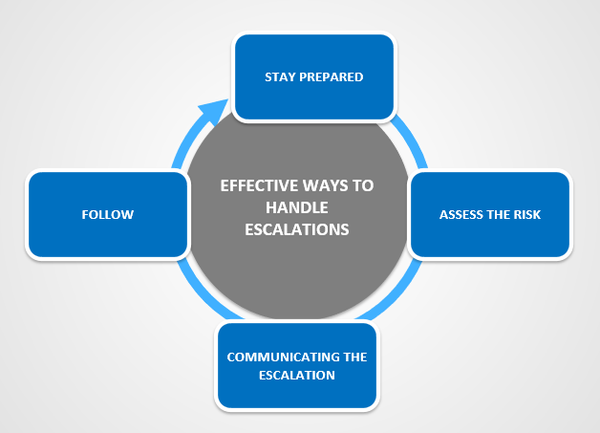Escalation Process - What is an Escalation Process in Project Management and How to handle Escalation?
Escalation Process in Projects
The escalation mechanism is already defined in most of the project plans, but in reality, only very few project managers make proper use of the escalation process. Many avoid escalation due to the fear of conflict, whereas, some overdo it by escalating every next issue in the project. Well, both approaches can harm a project. Therefore, escalating the problem of the project to the right person, at the right time, and with the right information is both an art and science that must be adopted by the project managers.

This guide focuses on an effective escalation process and the right way to handle it for project benefit.
What is an escalation?
In general, escalation means increasing intensity or magnitude by bypassing direct contact with the immediate person.
Applied to the context of a project, escalation is a formal process for highlighting the present issues to a high-level authority as per the defined escalation mechanism of the project.
For example, suppose a certain stakeholder of the project is not able or willing to do an activity for which they respond. It becomes necessary to escalate the problem to the superior authority for resolution.
Some of the common situations that call for escalations are issues or risks related to the project's objectives, scope disagreements, inter-group conflicts, dependencies on third-party, ambiguous responsibilities and roles, etc. Intervention by higher-level authority is required in such issues as often, the effort, decision making, authority, or resources required for resolving them are beyond the scope of authority of a project manager.
What is an escalation process?
An escalation process simplifies the channels and boundaries of decision-making within an organization for solving the problem quickly and effectively. The escalation process might also be called an escalation workflow that takes a high-priority issue to a high-level authority.
A project manager is accountable for proactively informing the problem to the decision-making body. The earlier the decision-making body knows about the issues, the better they could come across the problem before it worsens. But the challenge is that the higher authority or decision-making body is not in the situation, so they don’t have complete background information and don’t exactly know about the alternative ways to solve the issues. Therefore, the escalation process is the responsibility of the project manager and he/she is responsible for the whole process i.e., from detecting the problem to implementing the decision.
Below are the six steps describing an effective escalation process in projects:

- Step 1: Inform about the problem to the decision-making body (For example, marking project status report with a red flag).
- Step 2: Find what’s causing the problem and analyze what potential impact it can cause on the project (For example, delays or cost overruns).
- Step 3: The alternative options for the resolution of the problem are elaborated along with their benefits and drawbacks.
- Step 4: The situation is presented to the decision-making body along with a recommendation for the future.
- Step 5: It is explained to the decision-making body about what may happen if no decision is taken today (For example, delays or cost overruns).
- Step 6: The results of the escalation are documented to the decision-making body while also capturing the key points.
Who is an escalation manager?
Escalation managers are responsible for dealing with incidents and management problems within a system and ensure that the problems are addressed and resolved at the right level. The current scenario of an organization is analyzed by an escalation manager. And they highlight the issues that need an immediate response while also allowing the organization to track that problem, monitor it, and properly manage the escalating condition.
How do you handle escalations?
Before the matter is escalated, the project manager's responsibility is to ensure that all the required data is gathered and proper analysis is done. Many project managers get impatient to escalate the problem too quick without performing their share of duties and responsibilities.
Below are some of the effective ways to handle escalations:

- Stay prepared
- Assess the risk
- Communicating the escalation
2. Explain the major issues along with their implications – Always try to make it as short and simple as possible. This will make it easy to understand for everyone.
3. Explain the things that you did for avoiding the issue and also the escalation – This again should be kept short to avoid ending up with endless apologies.
4: Try to provide a proposal with a few resolution options – Propose two to three resolutions along with their effect on the present issue. Also, make a recommendation of the most suitable option.
- Follow up
Normally, some time is required for every escalation before implementing the agreed decisions by the project team and the project manager. So, it’s the duty of the escalation manager to keep the escalation committee informed about the progress and status until the problem and risk are resolved.


